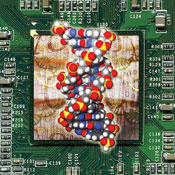Chemists from the California Institute of Technology (Caltech) and the Scripps Research Institute have developed an innovative method for producing cheap but extremely stable substances that could take the place of antibodies used today in many of the medical diagnostic tests

Chemists from the California Institute of Technology (Caltech) and the Scripps Research Institute have developed an innovative method for producing cheap but extremely stable substances that could take the place of antibodies used today in many of the medical diagnostic tests.
Researcher James R. Heath, professor of chemistry, along with K. Barry Sharpless, Scripps Institute professor of chemistry and 2001 Nobel laureate in chemistry, and their colleagues report the cutting-edge method in the latest issue of the journal Angewandte Chemie.
Last year Professor Heath and his colleagues reported the development of a combined barcode-blood chip, a medical diagnostic device the size of a microscope slide, capable of separating and testing dozens of proteins in a drop of blood. The barcode chip uses antibodies, proteins that help the immune system identify, bind to, and remove harmful foreign compounds such as bacteria and viruses - or other foreign proteins.
"The reason that limits us from testing, let's say, two hundred proteins at the same time on the barcode chip lies in the fact that we use proteins that are expensive and unstable," explains the researcher. "For a long time we have been frustrated by the limitations of antibodies and therefore we wanted to find effective substitutes for them - substances called "protein capture factors" - which are able to bind to a specific protein in a very selective and strong manner while maintaining their stability over a long period of time."
In their new research, the scientists succeeded in developing a method for the quick and cheap preparation of highly stable compounds, consisting of short chains of amino acids, or peptides. "I even flew from California to Chicago with a test tube that contained the compound and it was still active," notes the researcher.
The method is based on the "in situ click chemistry" approach introduced by Sharpless in 2001, an approach in which chemicals are produced by joining together - or click - between smaller subunits.
In order to produce a substance that captures a particular protein, the scientists developed a stepwise approach in which the first subunit is located, then this unit, combined with the appropriate protein, is used to locate the second subunit, and so on. For the first unit, a fluorescent tag is attached to the protein, which in the next step performs a reaction with a library of tens of millions of short peptides, which represent most of the potential structural units for the final capture material.
When one of these short peptides binds to the appropriate protein, the radioactive tag is activated and can be seen colored on the bead to which it is anchored (red, blue, or green, depending on the type of tag), thus enabling the identification of the desired protein-peptide conjugate.
The first peptide - which is about a third of the final size of the substance that the scientists are trying to obtain - is isolated in the next step, purified and attached to an active chemical group called alkyne. Now it is the anchor protein that undergoes another reaction, along with the same protein, with a peptide library. The peptide library at this stage contains proteins that have been modified so that at their ends there is another active chemical group called azide. The alkyne group in the first peptide reacts easily, using the click chemistry approach, with the azide group of the second peptide to create a new peptide that now consists of two units. However, the reaction occurs properly only when the second peptide can reach the proximity of the first peptide, meaning that both peptides should have a high affinity for the protein; Essentially, the protein itself directs the creation of its appropriate capture agent.
In the next step, the peptide consisting of the two parts is isolated and purified again, then one end is changed by inserting an active chemical group (alkyne or azide) as was done in the first steps to create a peptide consisting of three different parts. This peptide is long enough so that it can be selective and unique in its reaction with the target protein," explains the researcher.
"What the research has now shown is that in a small number of repetitions it is possible to create a ligand with a high affinity for a certain protein from structural units whose original binding to the protein was not strong; The idea is to repeat the scanning step of the material library several times so that the link improves with each such repetition," explains researcher Sharpless.
"This is the simplest type of chemistry possible," explains the researcher. The process, he points out, turns a very challenging task into a very simple one - the task of locating proteins that bind selectively and strongly to certain proteins. I don't see any reason why we can't replace any antibody with this method."

One response
A simple and brilliant idea.
Just like a child putting together a puzzle.